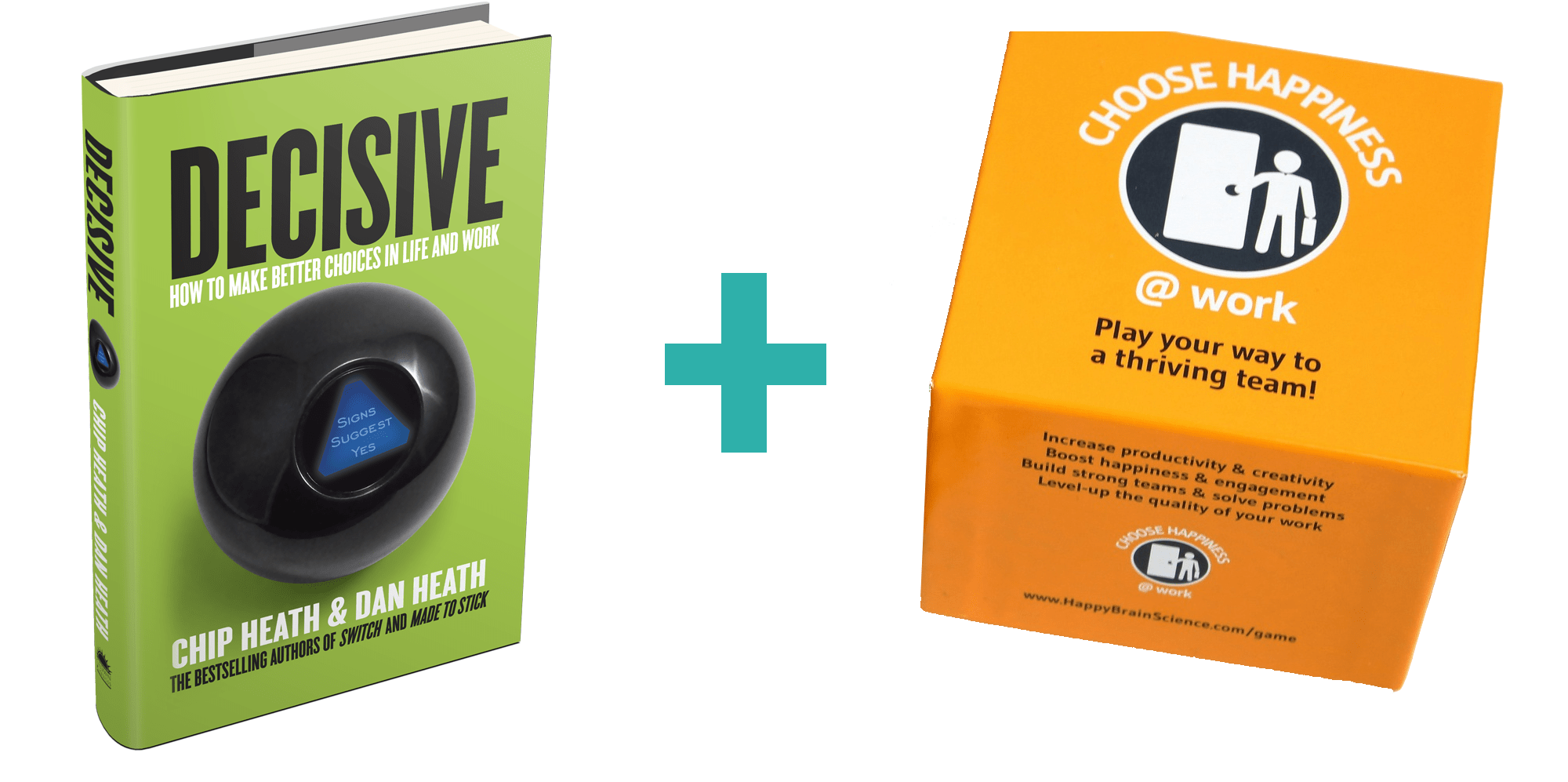
That’s a Wrap! How to Use the WRAP Model to Be More Decisive
How can you make good decisions when you’re creating something new? If you’re like us, you may find that the WRAP model (from the book Decisive) provides a great roadmap: Widen your options, Reality-test your assumptions, Attain distance before deciding, and Prepare to be wrong.
Diving into Decisiveness
At Happy Brain Science, we’re developing an online version of our science-backed card-game, Choose Happiness @ Work. Like creating any new product or service, the process involves making difficult choices every day. How do we balance scope, cost, and the time needed to develop the game? Which features are critical, and which are nice-to-have?
That’s where the WRAP model comes in. Decisive: How to Make Better Choices in Life and Work is a modern classic business book by Chip and Dan Heath. It dives into common pitfalls of decision-making, as well as techniques to avoid bad decisions. (Many excellent summaries of the book are available, including this video. The Heath brothers have also created lots of additional resources, including a free one-page overview of the WRAP model to help us all make better decisions.)
Curious what WRAP looks like in action? Here’s how we’re applying what we learned from Decisive to our game development process:
Widen Your Options, Be More Decisive
In many cases, when we consider our options for any given decision, we come up with only two choices—if we consider multiple options at all.
Early on, Scott was having trouble deciding whether to develop the game on his own versus hire an outside studio to develop it for him. He wanted to work on the game, but also needed to have time for other projects. He felt stumped about how to move forward.
Scott realized he needed to widen his sense of options—which opened up a third avenue for development.
Instead of staying in a narrow either/or, he was able to replace that binary approach with and. Now Scott is working on the game, and he is working with outside experts, and getting the benefits of both.
Reality-Test Your Assumptions
Playtesting is a process that allows developers to reality-test our assumptions about how a game works and identify which features are the most important. (More on that in a moment.)
But reality-testing our assumptions is not limited to features inside the game itself. Scott wrote about using a reality-testing technique to motivate himself to start working on the game in the first place. It created a shift that helped him overcome the fear of failure, get unstuck, and start seeking progress over perfection—and he’s continuing to use these insights to “test and learn” as part of the game development process.
This openness to reality-testing has already produced meaningful results: you can play with Scott’s first small experiment—the Choose Happiness @ Work Daily Happiness Boost—here.
Attain Distance Before Deciding
Developing games is a labor of love. It’s easy to become enamored of any given part of the game, and to stop seeing the forest for the trees. We naturally want this to be the best game ever, but that passion means that we can easily get stuck agonizing over minutiae, making each design decision a struggle.
In the world of game design, playtesting provides a built-in safeguard against getting too deep in the weeds. During development, we’ll be inviting groups of friends, family, and complete strangers to play our game and give us feedback. Playtesters will have a completely different perspective on how Choose Happiness @ Work Online is shaping up than we do. Seeing how they interact with the game—and with each other—will give us a wealth of much-needed perspective on design decisions.
Of course, just because this process is necessary does not mean it’s easy. Jesse Schell, author of The Art of Game Design, puts it best:
Playtesting is like an engraved invitation that reads:
You are cordially invited
to tell me why I suck
Bring a friend — Refreshments Served
Does playtesting have to be so uncomfortable? It does. The whole point of playtesting is to make clear to you that some of the decisions you were completely comfortable with are completely wrong.”
This partially explains why good decision-making processes are tough to come by—they’re tough!
Prepare to Be Wrong
Trying anything new involves failing, learning, and trying again. Fortunately, games teach us to view this process as fun instead of painful. We won’t always make the right decision—and when we don’t, it’s not the end of the world!
We know can set ourselves up for success by preparing for bad outcomes (What if the game doesn’t ship on time?) as well as preparing for good outcomes (What if it ships early?). As part of our development process, we hold regular strategy meetings to discuss how things are going and to plan for both success and failure. One helpful approach involves setting tripwires—events or pieces of data that, if we stumble across them, will trigger a meeting to reconsider our decision.
And when that happens, we’ll widen our options, reality-test our assumptions, attain some distance, and prepare to be wrong. Then we’ll take the next step—decisively.
Have you used any parts of the WRAP model to make better decisions? How have these strategies helped you be more decisive? Thanks for commenting below, connecting through any of our social media channels, or contacting us here.